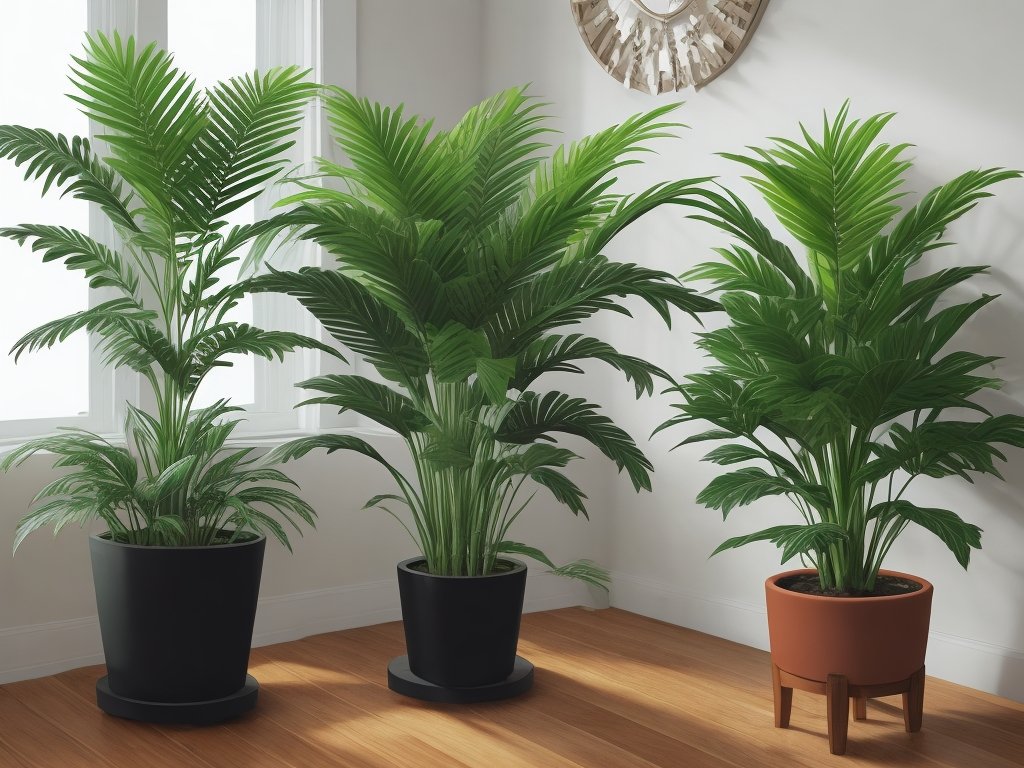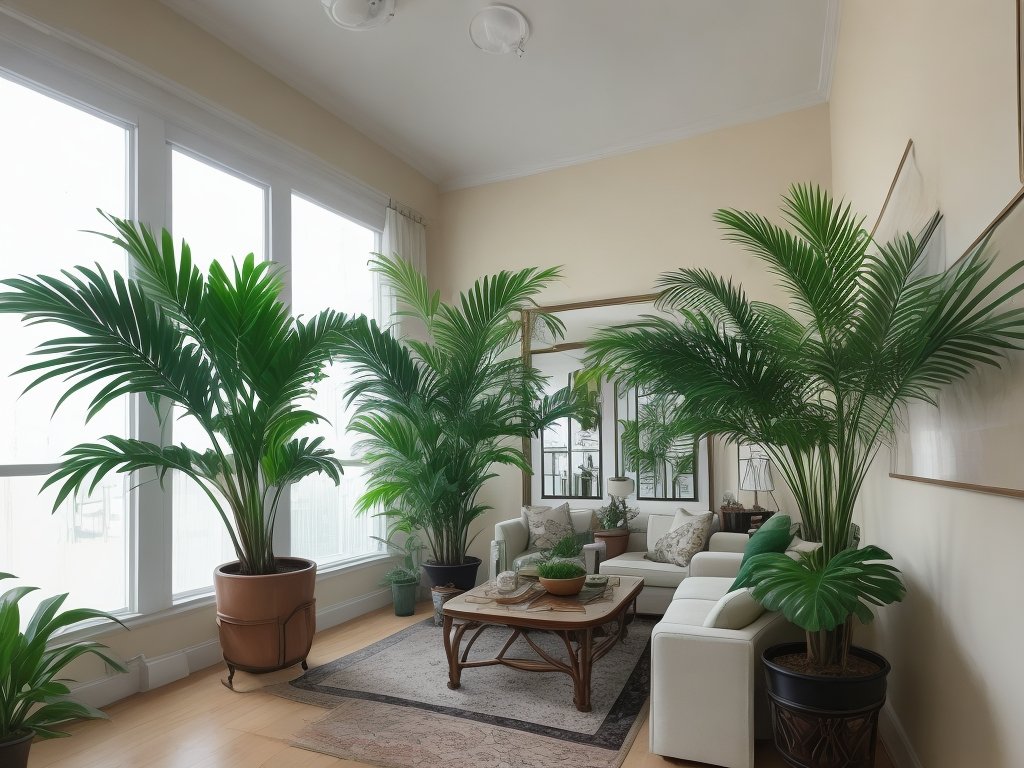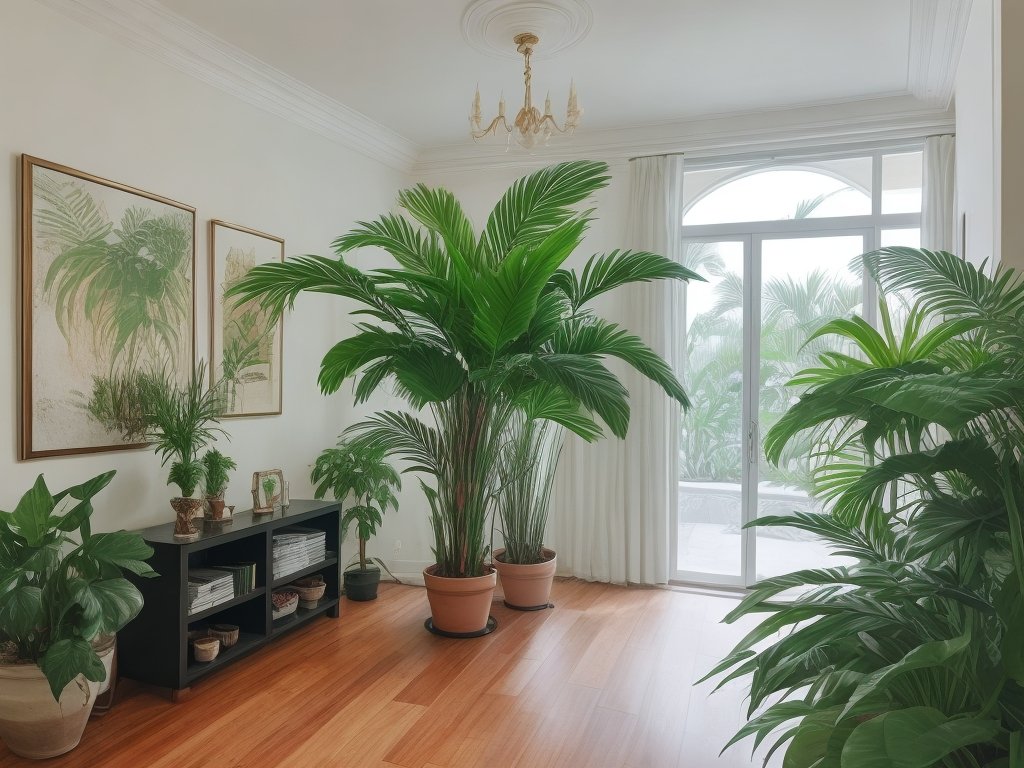Parlor Palm And Biophilic Design: Creating Natural Oasis in Modern Spaces!
Key Takeaways:
- Parlor palms are an excellent choice for incorporating biophilic design elements into your space.
- Utilizing parlor palms in your environment can enhance well-being and create a more calming atmosphere.
- Parlor palms are low-maintenance plants that can thrive in both indoor and outdoor settings.
- The presence of parlor palms can improve air quality by removing toxins and releasing oxygen.
Are you tired of feeling disconnected from nature in your own home?
Yearning for a way to bring the outdoors indoors and create a harmonious, natural environment?
Look no further than the parlor palm and the concept of biophilic design.
Biophilic design is all about incorporating elements of nature into our interior spaces, resulting in improved well-being, productivity, and overall happiness.
In this article, we will explore how indoor plants, especially the parlor palm, play a vital role in biophilic design, enhancing the visual appeal of our surroundings and improving air quality.
So, whether you’re a gardening enthusiast or simply seeking a serene living space, join me on this journey to discover the wonders of parlor palm and biophilic design.
| Category | Parlor Palm | Biophilic Design |
|---|---|---|
| Common Name | Parlor Palm | Biophilic Design |
| Scientific Name | Chamaedorea elegans | N/A |
| Origin | Central America, Mexico | N/A |
| Plant Type | Indoor Plant, Houseplant | Interior Design Concept |
| Growth Habit | Small, Slow-growing | N/A |
| Size | Average height: 2-4ft (60-120cm) | Variable, depending on implementation |
| Benefits | – Enhances indoor air quality – Adds greenery and aesthetics to space – Easy to care for | – Increases connection with nature – Improves well-being and productivity – Enhances indoor environment – Reduces stress and anxiety |
| Considerations | – Moderate light requirements – Requires well-draining soil – Tolerates average indoor humidity | – Integration with architecture or interior design – Careful plant selection and placement – Maintenance and upkeep |
What is biophilic design?
Biophilic design is an approach that incorporates elements of nature into interior spaces, creating a connection with the outdoors.
Definition of biophilic design
Biophilic design is an approach to architecture and interior design that seeks to connect people with nature in the built environment. It incorporates natural elements, such as plants, water, and natural lighting, to create spaces that promote well-being and enhance our connection to the natural world.
Benefits of incorporating biophilic design in interiors
Biophilic design has numerous benefits when incorporated in interiors. It creates a connection with nature, reduces stress, and improves air quality.
It enhances productivity and concentration, boosts creativity, and promotes overall well-being.
With biophilic design, indoor spaces become more inviting, calming, and visually appealing.
Importance of indoor plants in biophilic design
Indoor plants play a vital role in biophilic design by creating a connection with nature.
Role of indoor plants in creating a connection with nature
Indoor plants play a crucial role in creating a connection with nature in our indoor spaces. They bring elements of the natural world into our homes, offices, and other interior environments.
The presence of plants can evoke a sense of calm, tranquility, and overall well-being, as they remind us of the beauty and serenity found in nature.
Whether it’s a small succulent on a desk or a lush potted plant in a corner, indoor plants provide a visual and tactile connection to the outdoors. Additionally, indoor plants can improve air quality by filtering out pollutants and releasing oxygen.
They also contribute to reducing stress and promoting a positive mindset.
Taking care of plants can be therapeutic and fulfilling, as it allows us to engage with nature on a regular basis. So, whether you have a green thumb or are just getting started with indoor gardening, incorporating plants into your indoor spaces can help you establish a connection with nature and create a more inviting, rejuvenating environment.

How indoor plants improve air quality and reduce stress
Indoor plants improve air quality by absorbing carbon dioxide and releasing oxygen through photosynthesis.
They also remove toxins like benzene and formaldehyde from the air.
Moreover, being around plants can reduce stress levels and promote a sense of well-being.
Why the parlor palm is a perfect fit for biophilic design
The parlor palm is an ideal choice for biophilic design due to its ability to thrive indoors and enhance the visual appeal of indoor spaces.
The parlor palm’s ability to thrive indoors
The parlor palm thrives indoors due to its adaptability to low light conditions and its ability to tolerate a wide range of temperatures. It can grow well in various indoor environments, making it an ideal choice for biophilic design.
Its compact size also allows it to fit well in smaller indoor spaces, adding a touch of greenery and natural beauty.
How the parlor palm enhances the visual appeal of indoor spaces
The parlor palm enhances the visual appeal of indoor spaces by adding a touch of greenery and natural beauty. Its lush and elegant fronds create a soothing and calming atmosphere, making the space more inviting and aesthetically pleasing.
The parlor palm’s compact size and graceful growth habit make it a versatile plant that can be placed in various areas, such as tabletops, shelves, or corners, adding a pop of green and enhancing the overall ambiance of the room.
Whether you want to create a tropical oasis or bring a touch of nature indoors, the parlor palm is an excellent choice for enhancing the visual appeal of your indoor spaces.
Care and maintenance of the parlor palm
Taking care of your parlor palm involves providing ideal growing conditions, proper watering and fertilizing, and being aware of common pests and diseases.
Ideal growing conditions for the parlor palm
The parlor palm thrives in bright, indirect light but can also tolerate low light conditions.
It prefers average room temperatures between 65-75°F (18-24°C) and moderate humidity.
Plant in well-draining soil and water when the top inch of soil feels dry.
Avoid overwatering and direct sunlight.
Watering and fertilizing tips for the parlor palm
To keep your parlor palm happy and healthy, here are some watering and fertilizing tips:
- Water the plant thoroughly but allow the top inch of soil to dry out between waterings.
- Avoid overwatering to prevent root rot.
- Use well-draining soil to ensure proper water absorption.
- Fertilize with a balanced houseplant fertilizer every two to three months during the growing season.
- Dilute the fertilizer according to package instructions before applying.
- Avoid over-fertilizing, as it can lead to burned roots.
- Regularly wipe the leaves with a damp cloth to remove dust and promote better photosynthesis.
- With proper watering and moderate fertilization, your parlor palm will thrive and bring a touch of nature to your space.
Common pests and diseases affecting the parlor palm
The common pests that can affect the parlor palm are spider mites and mealybugs.
Spider mites can cause discolored leaves and webbing, while mealybugs appear as white, cotton-like clusters.
The parlor palm is also susceptible to root rot if overwatered.
Regularly inspect the plant for pests and ensure proper watering to keep it healthy.
Creative ways to incorporate the parlor palm in biophilic design
Get creative with adding parlor palms into your biophilic design to bring nature indoors and enhance the overall aesthetic.
Placement ideas for the parlor palm in different rooms
The parlor palm can be a great addition to various rooms in your home or office. Here are some placement ideas to consider:
- Living Room: Place the parlor palm near a window where it can receive indirect sunlight. It adds a touch of greenery and can help create a cozy and relaxing atmosphere.
- Bedroom: Position the parlor palm on a nightstand or a corner shelf to bring a calming and natural element to your sleeping space. It can also improve the air quality and contribute to a better night’s sleep.
- Home Office: Keep the parlor palm on your desk or on a nearby shelf. Its presence can contribute to a more productive and stress-free work environment. Plus, it adds a splash of green to your workspace.
- Bathroom: The humid conditions in the bathroom make it an ideal spot for the parlor palm. Place it on a countertop or a high shelf where it can thrive in the moisture and contribute to a spa-like atmosphere.
- Kitchen: Add the parlor palm to your kitchen countertop or windowsill. It not only adds beauty but also helps purify the air and create a fresh and inviting space.
Remember to consider the lighting and temperature requirements of the parlor palm when deciding on the placement in each room.

Pairing the parlor palm with other indoor plants for a diverse biophilic design
Pairing the parlor palm with other indoor plants is a great way to create a diverse biophilic design. Some plants that would complement the parlor palm include:
- Snake plant: The tall, sleek leaves of the snake plant contrast nicely with the feathery fronds of the parlor palm.
- Pothos: The trailing vines of the pothos can add a beautiful cascading effect when placed near the parlor palm.
- Peace lily: The glossy, dark green leaves of the peace lily create a nice contrast against the lighter foliage of the parlor palm.
- Boston fern: The delicate fronds of the Boston fern provide a lush, textured look when paired with the parlor palm.
By combining different indoor plants, you can create a visually appealing and diverse biophilic design in your space.
DIY projects using the parlor palm, such as terrariums and living walls
One great DIY project using the parlor palm is creating a terrarium. You can use a glass container and layer it with rocks, charcoal, and soil.
Then, carefully place the parlor palm in the terrarium and add some decorative elements like moss or small figurines.
Another option is to incorporate the parlor palm into a living wall. You can create a vertical garden by attaching a grid or trellis to a wall and planting the parlor palm in small pots or plant pockets.
This adds a beautiful, green focal point to your space and brings the benefits of biophilic design to new heights.
Frequently Asked Questions about parlor palms and biophilic design
How tall does a parlor palm grow?
A parlor palm can typically grow up to 4-6 feet tall indoors.
It’s a compact and manageable size, making it great for smaller spaces.
The slow growth rate of the parlor palm also means that it won’t quickly outgrow its surroundings.

Can parlor palms tolerate low light conditions?
Yes, parlor palms can tolerate low light conditions. They are known to be one of the best indoor plants for low light environments.
They can thrive in areas where other plants may struggle, making them a great option for spaces with limited natural light.

What other indoor plants are suitable for biophilic design?
There are several indoor plants that are suitable for biophilic design. Some popular choices include:
- Spider Plant: Known for its air-purifying properties and ability to adapt to various light conditions.
- ZZ Plant: A low-maintenance plant that thrives in low light and helps to filter toxins from the air.
- Pothos: A trailing plant that adds a touch of greenery and can grow in a variety of light conditions.
- Snake Plant: Famous for its ability to tolerate low light and improve indoor air quality.
- Peace Lily: Known for its ability to remove harmful toxins from the air and thrive in medium to low light conditions.
These plants not only add beauty to your space but also contribute to a healthier and more natural environment. So go ahead, choose the plants that resonate with you and bring nature indoors!
How often should I water my parlor palm?
Water your parlor palm thoroughly when the top inch of soil feels dry to the touch.
Avoid overwatering, as it can lead to root rot.
Monitor the moisture level and adjust watering frequency based on your specific indoor environment.
Can the parlor palm survive in dry climates?
The parlor palm is not well-suited for dry climates, as it thrives in humid conditions. It prefers environments with higher humidity levels and moist soil.
Dry climates can cause the leaves to turn brown and wilt.
Regular misting and a humidifier can help create a more suitable environment for the parlor palm.
Final Verdict
Biophilic design, with its emphasis on incorporating elements of nature into interior spaces, offers numerous benefits for both our well-being and the environment. Indoor plants, such as the parlor palm, play a crucial role in creating a connection with nature, improving air quality, and reducing stress levels.
The parlor palm is the perfect fit for biophilic design due to its ability to thrive indoors and enhance the visual appeal of any space.
Taking care of the parlor palm involves providing ideal growing conditions, proper watering and fertilizing, and addressing common pests and diseases. Creative ways to incorporate the parlor palm in biophilic design include strategic placement, pairing with other indoor plants, and engaging in DIY projects like terrariums and living walls.
Overall, the parlor palm is a versatile and resilient plant that adds a touch of nature to any interior, making it a great choice for biophilic design.







